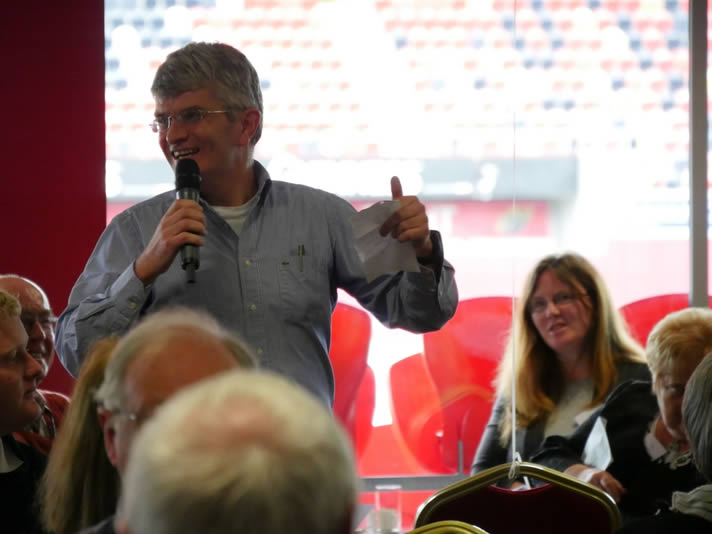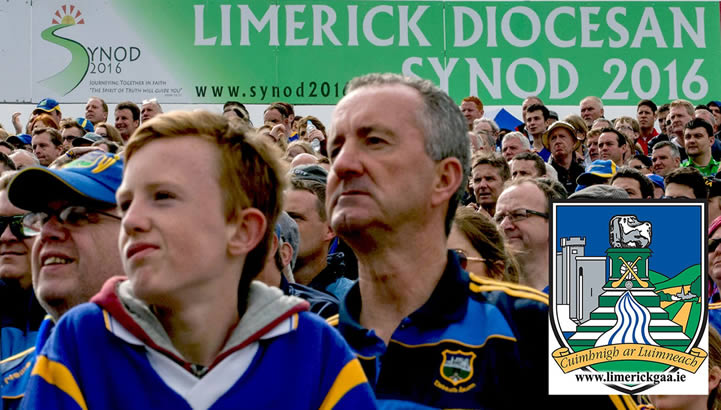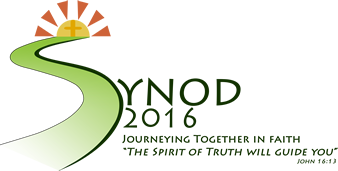Speaking Notes & Presentation of Fr. Éamonn Fitzgibbon
Input by Fr Éamonn Fitzgibbon to a gathering of delegates on Saturday June 27th in Thomond Park Conference Centre

Download Text to accompany presentation here (same as text below)
Slide One:
Those of you who know me will know that even though I am quite ecumenical in my sporting interests my heart really lies not so much in this wonderful ground of Thomond park but just over the road in the Gaelic grounds.
My first slide is a photograph from the match against Tipperary last Sunday and is of the Synod poster behind the goals – sadly it was about the only thing worth watching last Sunday!
Slide Two:
Bishop Brendan announced his intention to hold a Diocesan Synod by means of a Pastoral Letter entitled “Together in Mission”. In this letter Bishop brendan said ‘With this Pastoral letter I invite all of us in the Diocese of Limerick to set out together on a ‘Camino’.’
From my experience of walking the Camino on a number of occasions, sometimes alone and sometimes with groups, I know the value and importance of stopping along the way, taking stock, looking around and asking ‘do we have everyone, how are we getting on, where are we, where have we come from and where are we headed’?
Slide Three:
The journey is following the broad map of Theological Reflection. It believes that our everyday experience provides an agenda for our faith and that our faith has something to say to the everyday. Essentially it begins with ordinary everyday life and brings this into conversation with the Good News of the Gospel. This methodology is well tried and tested in Ireland as it forms the basis for Lectio Divina, Clinical Pastoral Education etc. However it is the adaptation of this method by the Belgian priest Joseph Cardijn and his pattern of See, Judge and Act (which inspired the Young Christian Workers movement) that gives us the clearest guide on our way.
See – This involves listening and gathering the issues of the people as expressed by the people – this stage is now coming to a close. Judge is discernment identifying what God is calling us to address from the issues raised. Its central decisive moment is the selection of themes for the Synod.
I want to communicate the sense that our diocese is very varied and has a lot of colour. Our delegates gathered here today are drawn from a wide variety of communities and the listening has engaged many communities. The following slides which have been prepared by the Geography Department of Mary Immaculate College convey something of this colour.
Slides 5,6,7,8:
These slides give us a sense of the parishes throughout the diocese and the spread of delegates throughout these.
Slide Nine:
We also have delegates from the Consecrated Life and we see in this map the widespread communities of Religious life.
Slides 10, 11, 12, 13, 14, 15, 16:
We also have delegates representing Education throughout the diocese and we see here the many Primary Schools and Secondary schools and also the three Third Level institutions.
Slide 17:
This slide communicates the level of Foreign nationals resident in Limerick City and County. There are parts of our city where over 55% of the population is made up of Foreign nationals and it is very important that we as a faith community pay attention to their needs and listen to their voice. Delegates have worked with Doras and listened in some of the Centres for Immigrants.
Slide 18:
We have a strong and vibrant Polish community and they are like a leaven in our diocese. This map communicates this reality. Again we have delegates representing this community.
Slide 19, 20:
We have one of the largest prisons in the country in Limerick and this slide reminds us that through the Bedford Row family project we can listen to the voice of prisoners and their families.
Slide 21, 22:
We also have Healthcare delegates who by means of Focus groups have listened to people involved in our Hospitals, Nursing Homes and Hospice.
Slide 23, 24:
These maps of the location of Halting Sites in Limerick City and County remind us of the need to listen and pay attention to the needs of members of the Travelling Community.
Slides 25, 26, 27, 28, 29:
I now want to move on to some graphs. I took a sample from the data, 25% of parish reports and 25% of non-parish reports to get a sense of the methodology, age and gender of the listening that has taken place.
You will see that in terms of age, parish and non-parish listening have served to correct each other. For example as you can see the parishes struggled to engage with the age group 19 to 35. However non-parish groups (for example primary school teachers or third level students have succeeded in engaging with this age group.
Unfortunately across both parish and non-parish delegates have struggled to engage with the male portion of our population with 30% of the overall being men.
In terms of methodology, we see that parishes were more inclined to use large meetings (assemblies) or questionnaires, while non-parish delegates used a variety of methods including informal listening and focus groups.
Slide 30:
We are now entering the ‘Judge’ stage which involves discernment to identify what God is calling us to address from the issues raised. Its central decisive moment is the selection of themes for the Synod. A team of ‘analysts’ has been assembled and they will combine Christian discernment, ethnography and data analysis in determining the themes emerging from the Synod listening. These analysts were trained by means of a workshop held on June 20th. This was a ‘fishbowl’ in which an inner circle of ‘experts’ from different disciplines held a conversation around analysing the data generated in the ‘See’ stage, surrounded by an outer circle – comprising those who would be conducting the analysis. This has given us some guiding principles on how to undertake the task of coding which will enable us to proceed in a manner that is truly ‘synodal’ – true to the rigours of data research but in a way that is consistent with Christian discernment. The next step will be to present the codes to the delegates in early Autumn and provide them with the opportunity, through a process of discernment, to determine the themes which will be brought forward to the Synod in April 2016.
Further out in the Autumn we will have to identify solid proposals for action.

